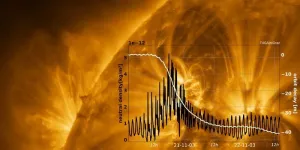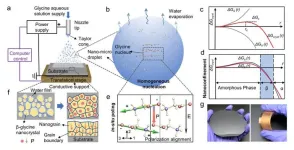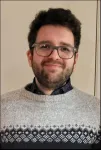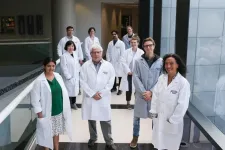(Press-News.org)
A team of researchers from the Keck School of Medicine of USC have published the first detailed description of the interplay between two cell types that allow lizards to regenerate their tails. This research, funded by the National Institutes of Health and published on August 10 in Nature Communications, focused on lizards’ unusual ability to rebuild cartilage, which replaces bone as the main structural tissue in regenerated tails after tail loss.
The discovery could provide insight for researchers studying how to rebuild cartilage damaged by osteoarthritis in humans, a degenerative and debilitating disease that affects about 32.5 million adults in the United States, according to Centers for Disease Control and Prevention. There is currently no cure for osteoarthritis.
“Lizards are kind of magical in their ability to regenerate cartilage because they can regenerate large amounts of cartilage and it doesn’t transition to bone,” said the study’s corresponding author Thomas Lozito, assistant professor of orthopaedic surgery and stem cell biology and regenerative medicine at the Keck School of Medicine of USC.
Lizards are among the only higher vertebrates capable of regenerating cartilage that does not ossify and are the closest relatives to mammals that can regenerate an appendage with multiple tissue types, including cartilage. Humans, by contrast, cannot repair cartilage that has been damaged once they reach adulthood.
Lozito explained that understanding how organisms with super healing powers regenerate tissue could help researchers find ways to recreate those processes in mammals.
“The dream is to find a way to translate that process in humans because they cannot repair cartilage,” said Lozito. “This represents an important step because we need to understand the process in great detail before we can try to recreate it in mammals.”
Key cells identified
First author Ariel Vonk, who is a PhD student in the Lozito Lab, and the research team determined that cells called fibroblasts, which help build tissue, are the critical cell type that builds cartilage in the lizard’s regenerated tail, the skeletons of which are almost entirely made of cartilage. The research described the changes in gene activity that took place among certain fibroblast cells that enabled cartilage building.
They also discovered that a type of immune cell called a septoclast plays an important role in inhibiting fibrosis, or scarring, allowing the process of regeneration to take place.
“Those two cell types working together laid the foundation for the beginning of the regenerative process,” said Lozito, who noted that a major difference between humans and lizards is that human tissue tends to scar and that scarring prevents tissue regeneration.
One future avenue for research, said Lozito, is to use single-cell RNA sequencing to better describe the molecular mechanisms that halt scarring in lizards so that they can try to recreate the process in mammals.
Cartilage regeneration induced in lizard limbs
Given what they learned about the cell types and molecular processes involved, the team ran tests to determine if they could recreate the process of rebuilding cartilage in lizard limbs which, unlike tails, do not regenerate after a loss.
They extracted septoclasts from lizard tails and implanted them into limbs, which were deficient in pro-regenerative immune cells found to be responsible for inhibiting scarring. They were able to successfully induce cartilage building in a lizard limb by recreating a tail-like signaling environment.
Lozito added that they hope to test whether they can induce cartilage building in mammals, beginning with mice, using the techniques they employed in their experiments on lizard limbs.
About the study
Additional authors of the study include Ariel Vonk, Xiaofan Zhao, Zheyu Pan, Megan Hudnall, Conrad Oakes, Gabriela Lopez, Sarah Hasel-Kolossa, Alexander Kuncz, Sasha Sengelmann, and Darian Gamble from the Keck School of Medicine of USC.
The research was funded by the National Institutes of Health (R01GM115444), and support from the Molecular Genomics Core at the USC Norris Comprehensive Cancer Center.
END
After a successful test phase, the Satellite Orbit DecAy (SODA) service, which was jointly developed by TU Graz and the University of Graz, officially became part of the ESA’s Space Safety Programme in mid-July. SODA provides accurate forecasts of the effects of solar storms on low Earth orbiting satellites. This makes TU Graz only the third Austrian institution contributing to this ESA programme. Seibersdorf Laboratories, and the University of Graz, through the Kanzelhöhe Observatory and the Institute of Physics, ...
Each year, more than 200 million people fall sick with malaria and more than half a million of these infections lead to death. The World Health Organization recommends parasite-based diagnosis before starting treatment for the disease caused by Plasmodium parasites. There are various diagnostic methods, including conventional light microscopy, rapid diagnostic tests and PCR.
The standard for malaria diagnosis, however, remains manual light microscopy, during which a specialist examines blood films with a microscope to confirm the presence of malaria parasites. ...
A research team led by The Hong Kong University of Science and Technology (HKUST) has developed a novel technique to self-assemble a thin layer of amino acids with ordered orientation over a large area that demonstrates high piezoelectric strength, making the manufacturing of biocompatible and biodegradable medical microdevices, such as pacemaker and implantable biosensor, in the near future possible.
The generation of bioelectricity from the piezoelectric effect – reversible conversion between mechanical and electrical energies – has physiological significance in living systems. ...
Acquiring real-time spectral information in point-of-care diagnosis, internet-of-thing, and other lab-on-chip applications require spectrometers with hetero-integration capability and miniaturized feature. Compared to conventional semiconductors integrated by heteroepitaxy, solution-processable semiconductors provide a much-flexible integration platform due to their solution-processability, and, therefore, more suitable for the multi-material integrated system. However, solution-processable semiconductors are usually incompatible with the micro-fabrication processes, making them far from practical use in various lab-on-chip applications.
In a new paper published ...
Immunothrombosis, or the formation of microscopic blood clots during inflammation, is a major cause of morbidity among patients with sepsis or severe COVID-19. A key enzyme in this process is thrombin. To date, no method exists for early detection of immunothrombosis in a living organism.
A team of investigators led by Ali Hafezi-Moghadam, MD, PhD, director of the Molecular Biomarkers Nano-Imaging Laboratory (MBNI) at Brigham and Women’s Hospital, a founding member of Mass General Brigham healthcare system, and an associate professor of Radiology at Harvard Medical School, developed a novel technology to diagnose immunothrombosis by measuring ...
TUCSON, Ariz., August 9, 2023 — Critical Path Institute (C-Path) announced today that Sanofi, a global leader in immunology and diabetes care, has joined its Type 1 Diabetes Consortium (T1DC). Sanofi joins T1DC as part of its commitment to push the boundaries of innovation to improve the lives of those with diabetes.
T1DC was established in 2017 with the goal to significantly advance the drug development landscape for T1D prevention and treatment. The consortium achieves this by fostering ...
Researchers are developing a way to incorporate one of the most human of characteristics – uncertainty – into machine learning systems.
Human error and uncertainty are concepts that many artificial intelligence systems fail to grasp, particularly in systems where a human provides feedback to a machine learning model. Many of these systems are programmed to assume that humans are always certain and correct, but real-world decision-making includes occasional mistakes and uncertainty.
Researchers from the University of Cambridge, along with The Alan Turing Institute, Princeton, and Google DeepMind, have been attempting ...
People with low levels of vitamin K in their blood are more likely to have poor lung function and to say they suffer with asthma, chronic obstructive pulmonary disease (COPD) and wheezing, according to a study published today (Thursday) in ERJ Open Research [1].
Vitamin K is found in leafy green vegetables, vegetable oils and cereal grains. It plays a role in blood clotting, and so helps the body to heal wounds, but researchers know very little about its role in lung health.
Researchers say their new findings do not alter the current advice on vitamin K intake, but they do support further research to ...
Sanford Burnham Prebys’ Cancer Center has received a rare and prestigious Merit Extension Award from the National Cancer Institute (NCI), recognizing and rewarding its earlier accomplishments as well as current research plans. The award extends the center’s current 5-year Cancer Center Support Grant (CCSG) for an additional two years.
There are only seven Basic Laboratory Cancer Centers in the NCI’s national network. These centers focus primarily on laboratory research: developing, conducting, translating and advancing fundamental discoveries to clinical testing and, ultimately, ...
In the ongoing search for a cure for Alzheimer’s disease, a burgeoning branch of medicine is bringing new hope. Stem cell therapies are already being used to treat various cancers and disorders of the blood and immune system. In a new proof-of-concept study, scientists at University of California San Diego show stem cell transplants may also be a promising therapeutic against Alzheimer’s.
In the study, publishing this month in Cell Reports, the researchers demonstrate that transplanting hematopoietic ...








